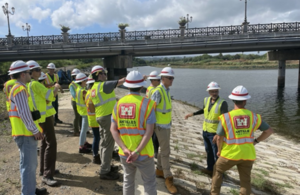The Levee Safety Partnership
The Levee Safety Partnership brings together experts from 3 countries to focus on emerging challenges and opportunities in flood defence infrastructure assets.

Levee safety Partnership, York 2023. Image credit: Environment Agency.
Levee Safety Partnership
Environment Agency (United Kingdom), Rijkswaterstaat (the Netherlands) and the United States Army Corp of Engineers (United States of America)
The Levee Safety Partnership (LSP) is a collaboration uniting engineers and researchers from the Netherlands, the USA, and the UK. It was established after Hurricane Katrina in 2004, when the United States Army Corps of Engineers (USACE) sought expertise from Rijkswaterstaat in the Netherlands to enhance levee safety risk management. In 2014, the Environment Agency joined the partnership.
The Environment Agency has Memorandums of Understanding (MoU) in place with both organisations, underpinned by mutual agreement. The purpose of the MoUs is the sharing of common technical interests, and to cooperate in the development of joint activities in the field of Integrated Water Resources Management. To support this, participants exchange scientific and technical information, participate in visits and staff exchanges, run a community of practice, seminars and workshops and share best practices and lessons learned.
Impact
In 2024 and 2025, the research focused on surface protection specifically improving resilience and biodiversity in both vegetation and soils. This led to a collated evidence base to support improvements in seed mix, where further trials are intended before adapting current practice.
Across 2023 and 2024 workshops helped to improve understanding on backwards erosion piping. Engagement with the has led to further research to improve the evidence base behind options for emergency response to asset failure.
The Levee Safety Partnership has raised awareness about levee safety topics, techniques, and technologies. This includes the development of the . Launched in 2013, the handbook offers international good practice on levees, based on knowledge and experience from 6 countries. It provides a guide to the evaluation, design, implementation, maintenance and management of levees and is relevant to the types of flood embankment managed by the Environment Agency, private owners and other operating authorities in the UK.
Alongside research and development, the partnership has also supported exchanging best practice. For example, in 2017 at a meeting in St. Louis, the members evaluated a levee using methodologies from the Environment Agency, Rijkswaterstaat and the USACE. This cross-comparison evaluation led to valuable lessons and the adoption of an 鈥淎merican Style鈥� assessment approach in the Netherlands.
Staff exchanges led by the partnership have helped build capacity and develop the skills and knowledge of professionals. In 2024, a USACE member relocated to England for several months, supporting a review of asset resilience and assessment of risk. This person presented the to the Environment Agency, demonstrating how it can enhance the Environment Agency鈥檚 RAFT+ tool. Later in 2024, a member of the Environment Agency relocated to the USA for a year to focus on potential improvements to Environment Agency standards and share best practice.
The partnership also runs an early career network. The network supports the development of younger engineers and scientists that are members of the partnership, typically within the first 5 to 10 years of their careers. It has created useful resources including country placemats describing context, governance and assessment methodology.
The impact extends beyond the partnership. The Levee Safety Partnership regularly updates and participates in the annual which is formed of over 100 countries and has a subcommittee on levees.聽Various spin-off groups have also emerged from the LSP, focusing on themes such as coastal zone management and incident management. The levee incident group is a parallel group that exists under the same Memorandum of Understanding, focused 聽on levee safety incident response.
Impacts have also included a Tolerable Risk Workshop (2008 and 2020) and a 鈥榦ne levee, three methods鈥� assessment review, where each nation applied the other nations approach to their levee and a SWOT analysis led to considered outcomes. A similar review on the approach to climate change (resilience), as well as country governance, strategies and methodologies has helped nations to consider options. The success of the group has led to further groups of a similar nature in coastal zone management, storm surge barriers, and incident management.
Resources
CIRIA. (2013). The International Levee Handbook. Available at: (Accessed: 24 March 2025).
Rijkswaterstaat. (2024). International Handbook on Emergency Management Flood Defences. Available at: (Accessed: 24 March 2025).
Rijkswaterstaat. (2025). International Partnerships. Available at: (Accessed: 24 March 2025).
United States Army Corp of Engineers. Levee Safety Program. Available at: (Accessed: 24 March 2025).
Funder
The Environment Agency research components of the LSP are 聽funded by the Flood and Coastal Erosion Risk Management (FCERM) research and development programme.
Collaborators
-
Environment Agency
-
United States Army Corp of Engineers (USACE)
-
Rijkswaterstaat
Research period聽
- Ongoing
Impact period聽
- Ongoing
Impact country聽
-
United Kingdom
-
United States of America
-
Netherlands
Contributing to areas of research interest
- 5 - Asset management